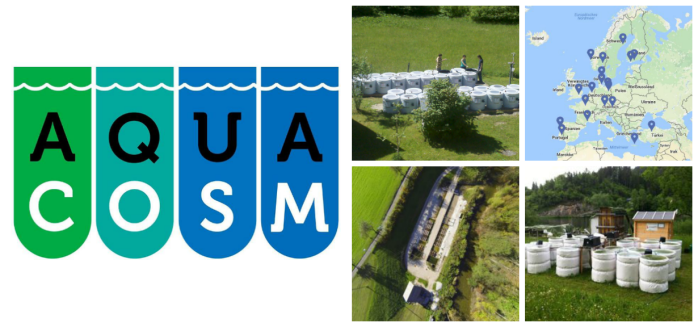AQUACOSM: Network of Leading European AQUAtic MesoCOSM Facilities Connecting Mountains to Oceans from the Arctic to the Mediterranean
Work Package 8: Autonomous measurements
Funding: EU H2020-INFRAIA
Leaders: Jens Nejstgaard (Project leader), Stella Berger (Transnational Access leader)
Our project partners: 20 partners (full list can be found here)
Project leader of the work package in WasserCluster: Robert Ptacnik

Project summary:
Rivers, lakes, estuaries and the open ocean are connected and it’s becoming evident that ecosystem processes act on many scales, including global. Despite this, aquatic research is still divided in marine and freshwater sciences, with separate funding sources, and experimental science is often conducted at single sites without international coordination. To challenge these problems, the FvB-IGB-lead project AQUACOSM is funded by the first international call (EU H2020-INFRAIA) to coordinate research, develop common best practices and open both freshwater and marine large-scale research infrastructures (mesocosms) for international cross-discipline participation.
AQUACOSM builds on the marine EU project MESOAQUA (2009-2012). Both networks are lead by Jens Nejstgaard, with Stella Berger coordinating the Transnational Access to the facilities. While MESOAQUA involved 6 marine partners, AQUACOSM greatly enhances this network. It is expanded with 2 small enterprises, 10 freshwater (rivers and lakes), 2 brackish and 2 benthic marine facilities, and involves 21 partners and over 50 scientists throughout Europe. It will offer much more Transnational Access, i.e. days to visit the mesocosm facilities. In total AQUACOSM will open for more than 340 worldwide users making up more than 11500 days. AQUACOSM will also integrate scattered know-how between freshwater and marine research infrastructures by uniting aquatic mesocosm science in an open international network, by involving enterprises in ambitious innovation processes to promote groundbreaking developments in mesocosm technology, instrumentation and data processing. Finally, a new dimension of experimental ecosystem science will be reached by coordinated mesocosm experiments along transects from the Mediterranean to the Arctic and across salinity boundaries and multiple environmental gradients.
Work Package Summary:
Within the project, our team contributes to multiple work packages, and leads WP8 dealing with the development of a best practice approach for (semi-) autonomous analysis of physical, chemical and biological parameters in mesocosm experiments. This WP will survey the relevant sensors and probes. Cost efficient setups will be co-developed in cooperation with leading providers of sensing devices. A key aspect is to enhance spatial and temporal resolution beyond the point feasible with setups routinely used to date. Within the context of global change (GC) research, WP8 will thus foster and demonstrate novel instrumentation systems enabling high-frequency observations in widely compatible data formats, describing ecosystem responses to GC and other anthropogenic pressures over European-wide environmental gradients.
The Joint Research Action will have two major impacts in the field of mesocosm-based aquatic research. (1) Enhancing spatial and temporal resolution which will allow a deeper insight in and modelling of key processes and interactions in the planktonic food web. (2) By fostering the development and spread of cost- effective gear, equipment for standardized data collection will become available to the community, allowing better comparability of experiments carried out in Europe and around the world. The approach will therefore be essential to make best use of results of international mesocosm research in terms of yielding reliable ecosystem response scenarios to GC and related anthropogenic pressures.